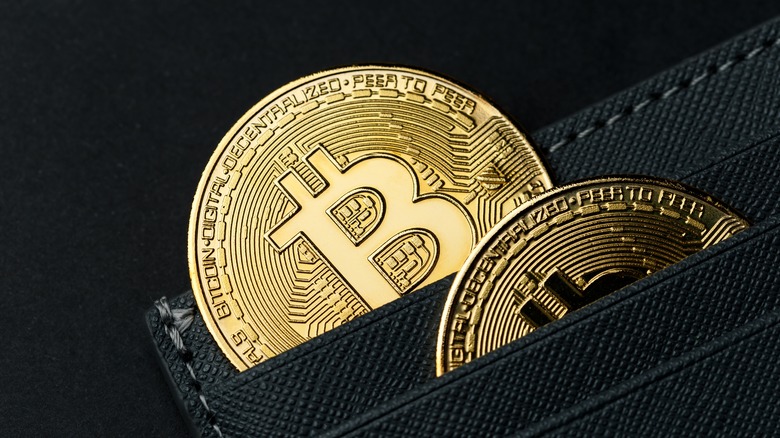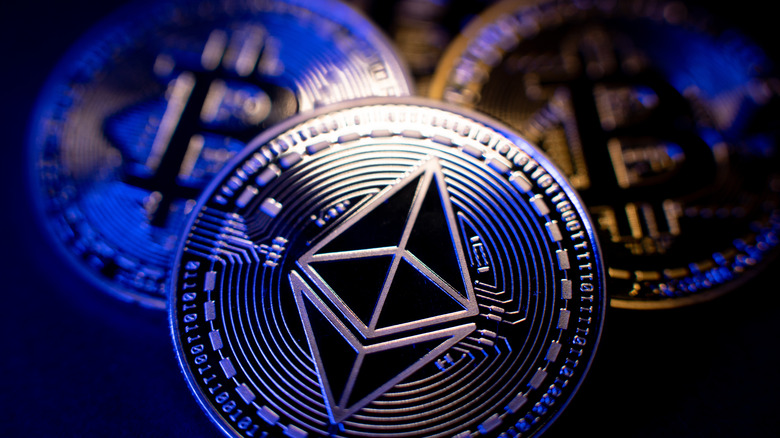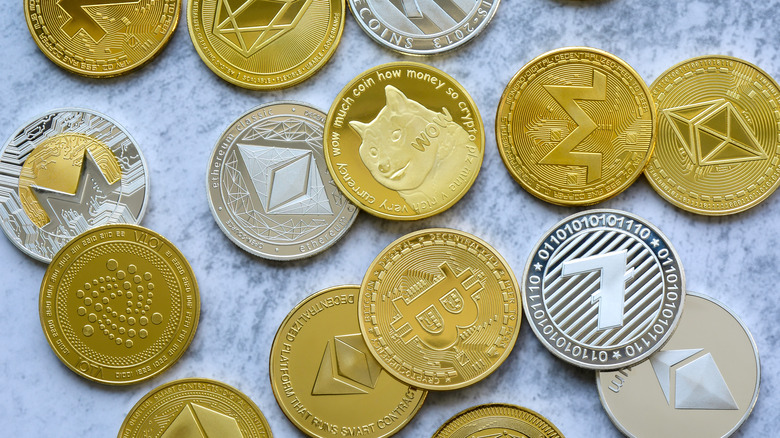Bitcoin Vs Ether: What's The Difference?
The idea for the creation of some kind of digital currency first came about sometime during the 1980s, but developers didn't have the tools — neither the protocols nor the software — to create that currency at the time and on through the 1990s, per Analytics Insight. But even after the tools were made available, it would take more than another decade before an anonymous entity known as Satoshi Nakamoto would publish a paper proposing the existence of a "peer-to-peer version of electronic cash [which] would allow online payments to be sent directly from one party to another without going through a financial institution" (via Bitcoin.org).
The brief, nine-page paper further proposed that in order to keep currency from being owned by several parties, or spent by one owner more than once (aka "double spend"), all transactions would be encrypted but kept in the public space, and would be verified by "a chain of digital signatures," similar to that of a digital ledger. Analytics Insight credits that paper and the ideas in it with the birth of Bitcoin.
While CNBC says there are nearly 20,000 different cryptocurrencies and blockchain platforms in the digital space today, not all of them are expected to survive in the event of an industry shakedown. For now at least, the top of the pack is dominated by two names: Bitcoin and Ether, which Forbes describes as the "Coca-Cola and Pepsi of the cryptocurrency space."
Bitcoin, explained
Bitcoin is cryptocurrency. It's universally accepted and is meant to be used to settle online or real-world transactions. Bitcoin didn't come into being until January 3, 2009, when "Satoshi Nakamoto," who wrote the original paper proposing the creation of peer-to-peer electronic cash, was listed as the miner for the first Bitcoin.
Bitcoin's integrity is built on the premise that every one of its transactions is open to the entire network (aka "nodes") and that information on all current transactions is collected every 10 minutes by miners, verified by solving a crytograph, and added to a chain of verified electronic signatures known as the blockchain, per New Scientist magazine. The publication also says Bitcoin is safe because it uses cryptography designed by the U.S. National Security Agency, which makes it almost impossible to hack into. This means that anytime reports surface of cryptocurrencies being stolen by hackers, what it likely means is that the websites that host Bitcoin were hacked into, rather than any hackers breaking into the Bitcoin network itself.
There are a number of ways to get Bitcoin — one of them is to buy the crypto at a currency exchange in exchange for real money. You can also to pick up Bitcoin from apps like Robinhood, or through real-life brokers. You can even "mine" Bitcoin by guessing and solving cryptographical puzzles using powerful computers. As of now, there can be only 21 million Bitcoins in existence, only half of which have been mined, which has driven its price up.
Ether, explained
You might not have heard of Ether as much as you've heard of Ethereum, but the two are very much connected. Like Bitcoin, Ethereum began as a "project" and a white paper by Vitalik Buterin, which was meant to try and sort out the issues Bitcoin's creation had raised. According to CNBC, Buterin compared Bitcoin to a calculator that "does one thing well," while he considered Etherium to be more like a smartphone.
Unlike Bitcoin, which is a currency, Ethereum describes itself as a "marketplace of financial services, games, social networks, as well as other apps." Bitcoin's equivalent in the Ethereum world is the digital currency Ether (ETH), which can be used in the same way Bitcoin can be used — that is, to pay for goods and services, and to move money across borders without the hassle of going through a physical, third-party agency like a financial institution. But unlike Bitcoin, which can be used like cash, Ether can only be used within the Ethereum world.
Before you can get hold of any Ether, you need to have an Ethereum wallet; once you have one, like Bitcoin, you can become an Ether miner and earn the currency by validating transactions that take place. You can also buy Ether, swap Ether for Bitcoin, or even get Ether transferred to you.
Other types of cryptocurrencies, explained
While there may be more than 20,000 cryptocurrencies in existence, the industry has already experienced a shakeup that's seen the failure of at least 1,000 different coins. Some of these failures were the result, ironically, of the involvement of big banks, whose presence cryptocurrencies were originally meant to negate; while others have been hurt by moves from hackers to steal cryptocurrencies from digital platforms, resulting in the loss of tens of millions of dollars. And in one of the most unusual cryptocurrency losses — the sudden death of a crypto founder meant that his passwords died with him, an event that led to the subsequent wipeout of $137 million dollars of unrecoverable investments. An auditor finally found his way into the system, only to find that everything had been liquidated before the founder died.
Still, there are a number of cryptocurrencies that credible financial advisers are happy to hang their hats on — one of them being Tether (USDT), which is considered a "stablecoin" because it's linked to something physical; in this case, the U.S. dollar. Another crypto of note is the BNB, which is backed by Binance, considered to be one of the biggest crypto traders in the world. And you might have even heard of Dogecoin (and its Shiba Inu mascot), which has an unlimited number of coins..



